Updated December 31, 2022
How do you assemble a perfect travel first-aid kit, yet still manage to pack light? I don’t claim to have a universal solution, but the following works for me.
Table of Contents
- How to assemble a perfect travel first-aid kit
- 1. Identify your needs in travel first-aid kit
- 2. Never packing ‘what-if’ items doesn’t apply to a first-aid kit
- 3. Build your kit from scratch
- 4. Get sound advice
- 5. Help out other travellers if possible
- 6. Adopt packing light strategies
- 7. Get prescriptions filled before departure
- 8. Verify the legality of your medication in your destination country
- 9. Label everything
- 10. Have access to medicinal information and first-aid advice
- 11. Review your kit before each trip
- 12. List kit contents
- 13. Identify factors affecting kit contents
- 14. Individualize your kit
- 15. And to complement my first-aid kit…
- 16. Back home, reach into the travel first-aid kit
- In summary…
How to assemble a perfect travel first-aid kit
Use these 15 tips to assemble a perfect travel first-aid kit considering your destination, activities, and health needs while still packing light.
1. Identify your needs in travel first-aid kit
Each kit is different. A first step is figuring out what you expect of yours. Here are some ideas:
- It has what’s needed to respond to illness and injuries given the destination, season, activities, and health needs of those who depend on the kit.
- It contains enough supplies to deal with minor injuries and illnesses until it’s possible to get to the nearest clinic or pharmacy. Besides, no one wants to spend valuable travel time navigating a new destination, especially when feeling unwell.
- It takes existing health issues into consideration, and travel related injuries and illnesses given past experience.
- It contains trusted supplies written in a familiar language and acquired at a cost that may be cheaper at home than at your destination.
- It’s small enough, and light enough, to carry at all times (or have key items always accessible).
2. Never packing ‘what-if’ items doesn’t apply to a first-aid kit
Packing light travellers advocate never packing ‘what-if’ items.
A first-aid kit is an exception. It’s like that emergency medical insurance you hope to never have to use. Returning home with a kit that was never opened, or tossing expired medication that was never used, are indications of healthy, injury-free travels.
3. Build your kit from scratch
Assemble your own first-aid kit. It gives you more control over the contents and the container. By all means, look for clues from pre-assembled kits, but there’s a good chance an off-the-shelf kit won’t meet your needs. Cobble together your own, considering your destination, activities, and health needs. Chances are it will be cheaper, lighter, smaller, and more useful than a generic version.
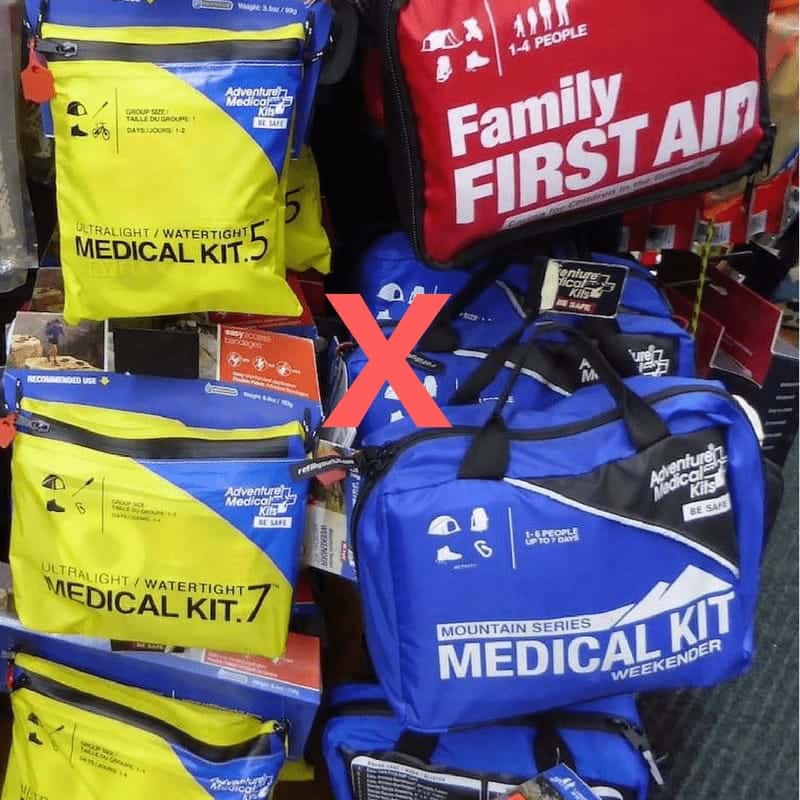
4. Get sound advice
Bloggers, especially those with a healthcare background, are helpful sources of ideas. For specific advice, consult a professional health care provider. Your family doctor and pharmacist are aware of your health issues, and can suggest compatible OTC (Over-The-Counter) medication. Your pharmacist can also provide suggestions on generic (and cheaper) alternatives to brand-name products. A travellers’ clinic specializes in preparing people for worldwide travel.
5. Help out other travellers if possible
Unhealthy or injured travelling companions impact on all members of a group. My first-aid kit has responded to the occasional health issues of others, and I’ve been the grateful beneficiary of supplies from another person’s kit.
The right supplies in the right quantities add very little weight, and are invaluable if they allow everyone to get on with their travels.
- While cycling beside the canals of the Netherlands, a blister pack containing two Tylenol tablets treated a companion’s splitting headache.
- A couple of Loperamide tablets enabled us to continue exploring Singapore when my nephew was suddenly struck with an attack of Travellers’ Diarrhea.
- When hiking the trails of Plitvice Lakes National Park in Croatia, a piece of anti-blister tape protected a friend’s heel from further chafing.
- When hiking the Banks Track in New Zealand, another hiker gave me some hiking wool to help prevent chafing of sensitive areas.
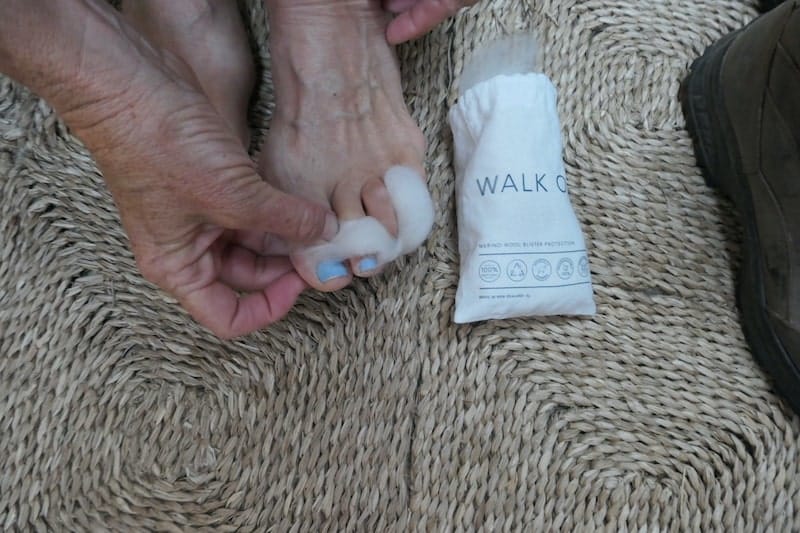
6. Adopt packing light strategies
If your kit is large and heavy, you’ll be tempted to leave it at home, or back at your accommodation. A first-aid kit should be small enough, light enough, and functional enough to have a permanent place in your day bag.
- Look for travel-friendly sizes. Check out truck stops, drug stores, dollar stores, and hiking and outdoor stores for products packaged in small sizes. Google “OTC medication travel sizes” and you may discover online suppliers in your country of residence. This is how I stumbled across minimus.biz with their range of single-dose blister packs of OTC medication and first-aid supplies.
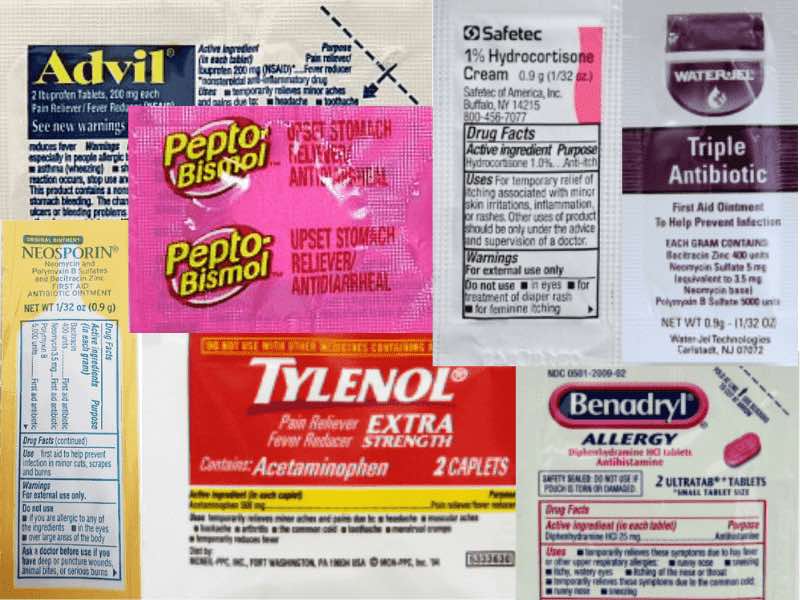
- Dollar-store purchases tend to be much cheaper than those available elsewhere. I find it hurts less to discard expired medication or have folding scissors confiscated by an overzealous security agent if I paid dollar-store prices for the item.
- Where feasible, choose blister packs of tablets over bottles and liquids, and single-dose blister packs over tubes and bottles.
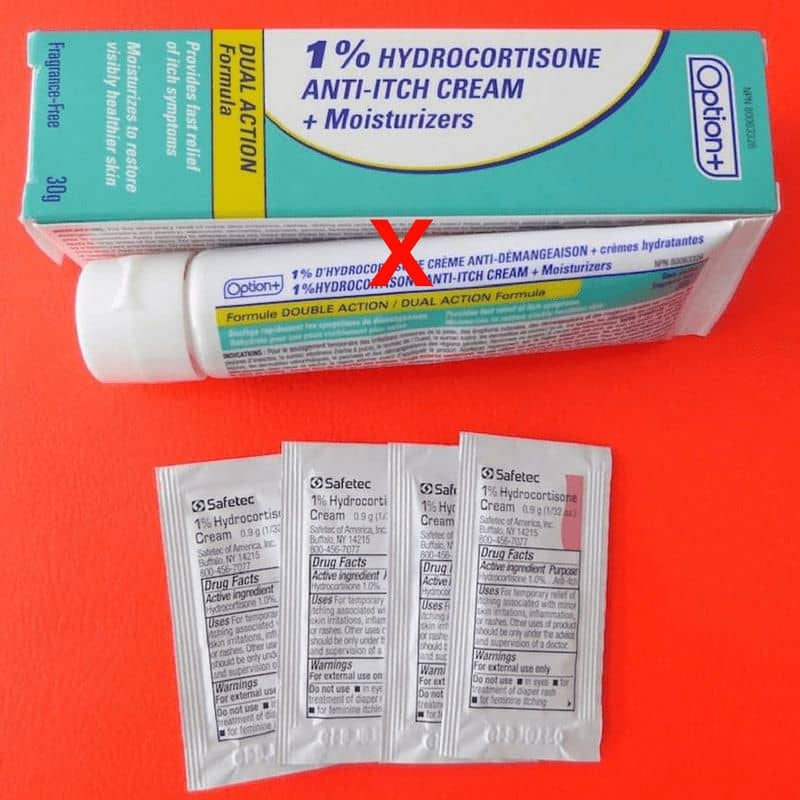
- Where feasible, transfer or decant to smaller containers.
- Use see-through zip-top pill pouch bags to separate various products.
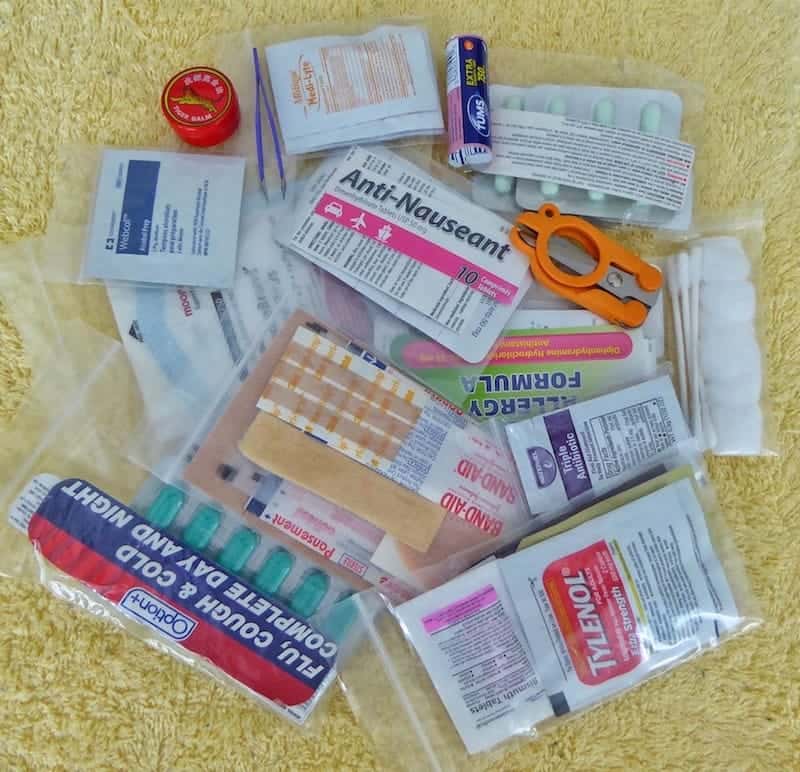
- Choose a container for your kit that slips easily into a day bag. It will need to be waterproof if you’re involved in activities around water. Otherwise, carry a spare zip-top bag, dry bag, or a rain cover for your daypack.
- Pack a pocket pill container for storing medication and supplements for use while in transit or on the move.
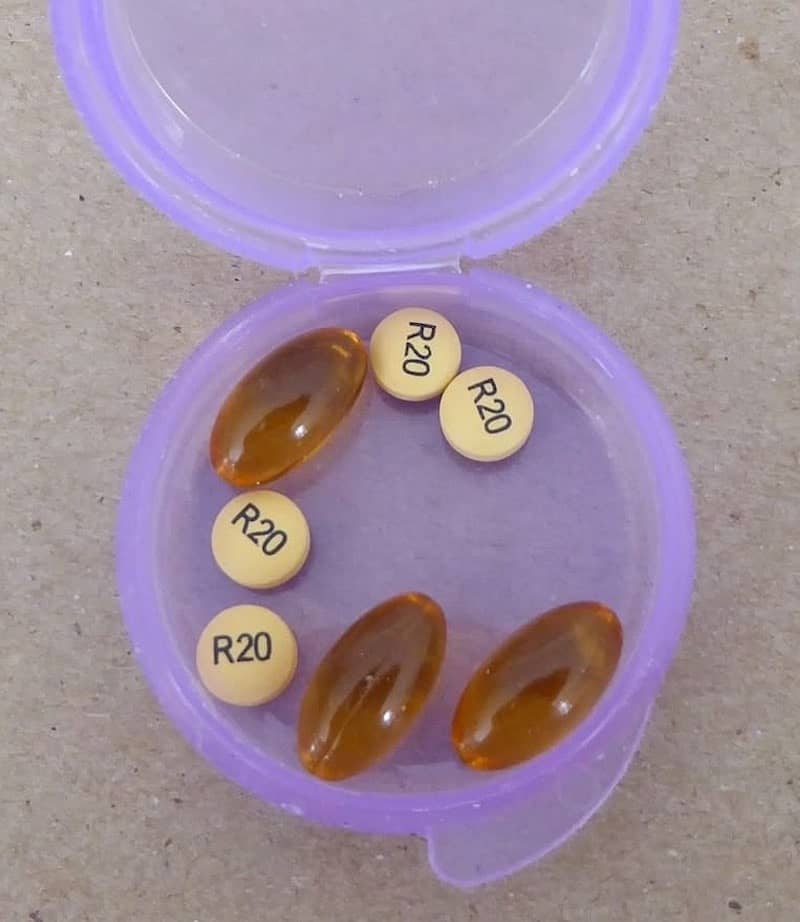
7. Get prescriptions filled before departure
Your prescriptions are valid only in your home country. Get them filled before leaving home. Pack quantities needed for the duration of the trip, and extra to cover possible travel delays. Ask your pharmacist for the smallest possible labelled container, and ask for the expiry date to be listed.
Scan the information sheets received with the medication, and take the electronic copies with you. For this purpose, I use the app Scanner Pro and cloud-based app, Dropbox.
8. Verify the legality of your medication in your destination country
Medication that may be legal at home might be illegal in another country. Many countries have their own rules regarding travelling with medication.
Start with an online search for ‘travelling with mediation to ___’ and review the information on authority sites such as the pharmaceutical agency of the country in question. If in doubt, contact the embassy or diplomatic mission for additional information.
If you need to administer any medication with a syringe, it would be wise to obtain a letter from your doctor indicating it’s for personal use.
9. Label everything
Don’t separate medication from the manufacturer’s packaging. Keep medication in its sealed package or blister pack to protect its integrity, stability, and effectiveness.
The manufacturer’s packaging helps promote safe use by providing information on medicinal ingredients, dosage instructions, and expiry dates. It’s also useful information to help respond to possible inquiries of border services agents.
Having the medicinal ingredients at your fingertips is handy when trying to purchase additional supplies across a language barrier. If you separate medication from its box, cut up the box and slip the pieces containing relevant information into a small zip-top bag with the blister tabs.
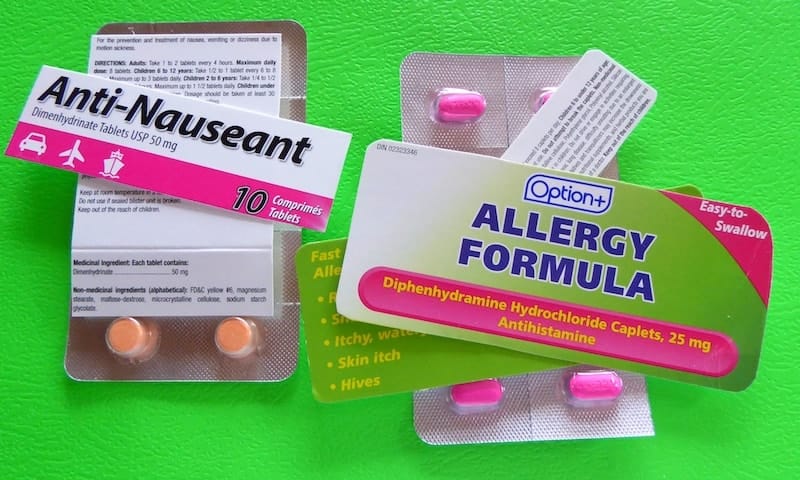
For supplements and probiotics, I find the containers take up too much space. Zip-top bags and reusable prescription containers offer downsizing options.
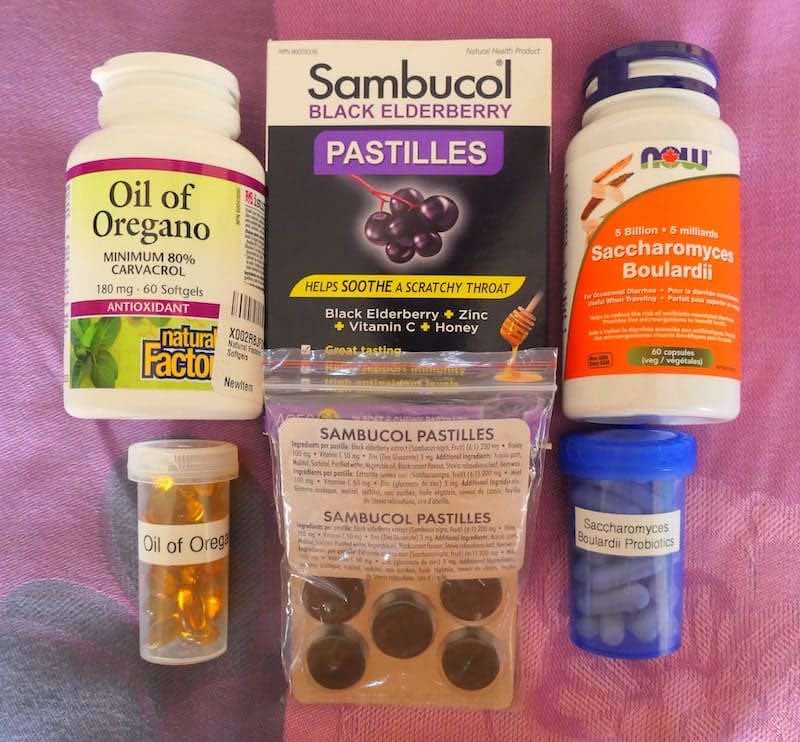
10. Have access to medicinal information and first-aid advice
Before packing or taking any medication, consult an authority site for information and advice.
- How should it be safely stored?
- What temperatures affect its effectiveness?
- Will it cause drowsiness?
- What can or can’t be taken with it?
- Can it be taken on an empty stomach?
- What’s the suggested maximum dosage within a 24-hour period?
Drugs.com is an excellent resource, as is the Traveler Advice Page of the US Centers for Disease Control and Prevention. The Canadian Red Cross First-Aid app is a useful resource for emergency first-aid advice.
11. Review your kit before each trip
Remaining committed to carry-on travel requires packing with time to spare. I tend to start at least a week before departure, and definitely earlier if I know my first-aid kit needs refreshing. It helps to break packing into manageable chunks, usually by category such as ‘toiletries,’ ‘first-aid kit,’ or ‘clothing.’ For the first-aid kit, this means time to:
- discard expired medication
- replenish low supplies or missing items
- remove or include destination- or season-specific items
- communicate with others, if not travelling solo, to lighten the load by sharing supplies across first-aid kits.
12. List kit contents
A detailed list of the contents of your first-aid kit, and those items that complement what’s in the kit, can be helpful. Brand names (and their generic equivalents) aren’t available in all countries, so it’s important to include the medicinal ingredients of each. Store it in a cloud storage app, or where it’s readily accessible on your device.
A list…
- keeps you organized when it comes to replenishing or removing supplies;
- is helpful when seeking advice from health care professionals;
- is useful when consulting with travelling companions on sharing first-aid supplies;
- is a reference to avoid overdosing when taking combinations of different medications (e.g., “Tylenol Poisoning” is a real problem; some cold-and-flu medication also contains Acetaminophen/Paracetamol);
- enables you to purchase depleted items with the same or similar medicinal ingredients at your destination; and
- can be easily updated for future travels.
13. Identify factors affecting kit contents
Take into account your own health needs and previous experience in managing them. For example, here are some of the things I considered for recent trips.
Blister prevention and treatment. It’s not uncommon to walk 20 km / 12.5 mi each day, more than at home. Also, feet change. Shoes that fit perfectly when they were purchased might not remain so.
Allergic reactions to insect bites. Biting insects are my nemesis. The New Zealand sandflies sent me scurrying for antihistamine, and bites from some unknown insect in Australia landed me in the emergency department of a hospital (at a considerable cost) to get a prescription for an antibiotic (that cost $5 to fill). I now ask my doctor for a prescription for both an antibiotic ointment and tablets that can be filled before leaving home.
Digestive ailments. I take medication for acid reflux. This means that Acetaminophen/Paracetamol (e.g., Tylenol) is a safer pain reliever than Ibuprofen (e.g., Advil). Also, with reduced acid in my stomach, I always expect Travellers’ Diarrhea. I also need to plan to deal with occasional and very uncomfortable heartburn.
Minor scrapes. Most trips involve time on a bike or scooter, increasing the chance of minor scrapes and abrasions.
Respiratory issues. I have a propensity for a bad case of the ‘flu to morph into pneumonia. After remaining insanely healthy during the pandemic, I expected to fall prey to Covid or influenza on my first post-pandemic international trip. This pointed to the need to pack Covid test kits, and my doctor gave me prescriptions for an antibiotic and a puffer, both filled before leaving home.
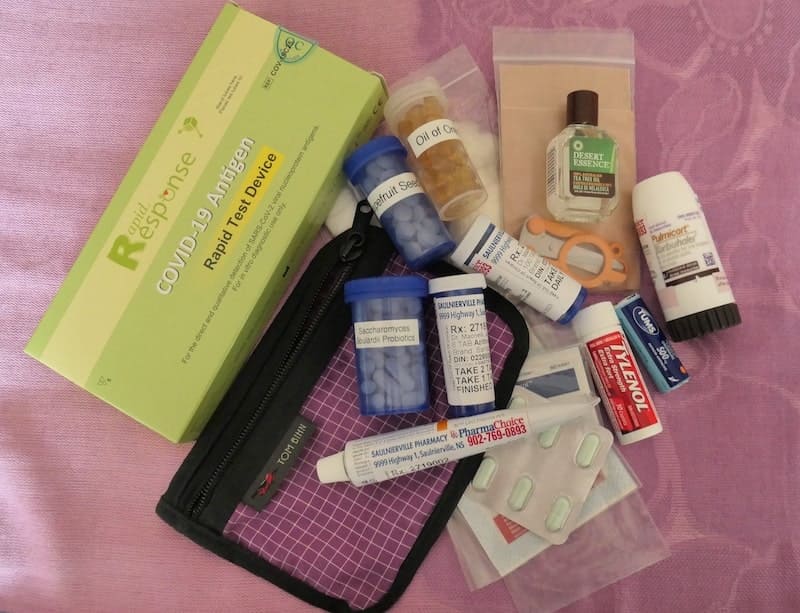
Staying healthy on long-haul flights. Planes harbour harmful bacteria, and long flights increase the risk of Deep Vein Thrombosis. The dry environment contributes to dehydration, dry skin, and sore nasal passages.
14. Individualize your kit
In the event it’s helpful, here’s a list of the contents of my kit, based on the considerations described above, and the advice of my family doctor and pharmacist. I favour generic alternatives to brand-name products as they can be considerably cheaper.
- Anti-diarrhea (e.g., Imodium): Loperamide hydrochloride 2 mg when a blocker is required (e.g., on transit days)
- Antihistamine allergy relief (e.g., Claritin): Loratadine 10mg
- Topical antibiotic for skin infections: Sodium Fusidate 2% (prescription)
- Oral antibiotic for skin infections: Amoxycillin/clavulanic 875/125 mg (prescription)
- Antibiotic for respiratory/bronchial bacterial infections and severe Travellers Diarrhea: Azithromycin dehydrate 250 mg (prescription)
- Anti-nauseant (e.g., Gravol): Dimenhydrinate 50 mg
- Blister prevention and treatment: Dr. Scholl’s Moleskin Plus; Moleskin pre-cut and shaped by Adventure Medical Kits; Polysporin Blister Treatment Cushions; Spenco 2nd Skin Adhesive Knit; blister prevention wool; BAND-AID® Blister Cushion
- Cough, cold and ‘flu relief: Sambucol Black Elderberry Pastilles
- Heartburn relief: Tums Extra Strength (Calcium carbonate 750 mg)
- Antiseptic: tea tree oil
- Miscellaneous aids: cotton wool buds (Organyc); cotton balls; tweezers (remove splinters, thorns, ticks, debris); safety pins (remove splinters, thorns, fashion a sling, miscellaneous uses); folding scissors (Fiskars)
- Pain relief, fever reducer: Extra Strength Tylenol (Acetaminophen 500 mg)
- Wound care: MooreBrand Gauze Pads (2” x 2”); Webcol Alcohol Prep Pads (Isopropyl Alcohol 70%); 3M Steri-Strips; waterproof bandages; variety of sizes and shapes of plasters
All these supplies fit in a soft-sided zippered packing organizer measuring 17 x 10 cm / 7 x 4 in and weighing 218 g / 7.7 oz.

15. And to complement my first-aid kit…
- compression socks
- clear duct tape (to keep a bandage in place)
- emergency ID bracelet
- flashlight: FourSevens MiNi X
- immune support: Ener-C drink mix; NOW Oregano Veg Capsules 450 mg
- insect repellent: Mosquito Shield Piactive (Icaridin 20%)
- electrolyte hydration supplement (exercise, flights, hot climates): NUUN Sport
- Nature’s Aid all-natural skin gel with healing and soothing properties for allergic reactions, minor scrapes, sunburn, and inflamed muscles
- laminated Emergency Contact Card
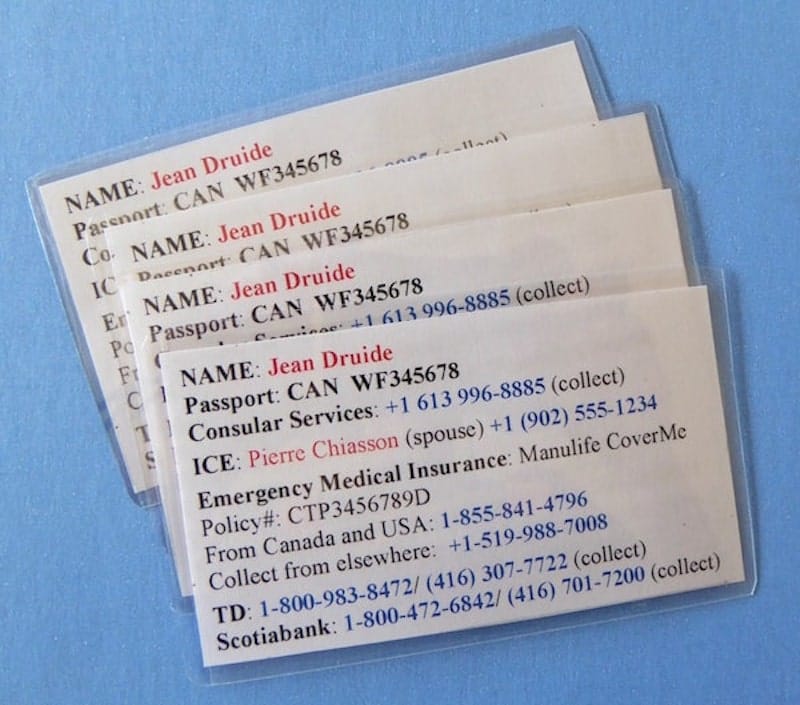
- nasal soreness: Boroleum (Petrolatum 97.92%; Camphor 1%; Menthol 0.54%)
- pashmina (doubles as a makeshift sling)
- probiotics: Saccharomyces Boulardii
- activated charcoal
- sanitizer
- sanitizing wipes: EO Lavender plastic-free bamboo wipes
- Soap Leaves: Sea to Summit
- sunscreen: All good sunscreen butter
- tablet towels
- reusable dry bag to make an ice pack
16. Back home, reach into the travel first-aid kit
Rather than keeping separate supplies in a home medicine cabinet and a travel first-aid kit, anything with an expiry date should be utilized when it’s needed. Purging a a travel first-aid kit of expired medication can be costlier than it needs to be, especially if you’ve enjoyed healthy and injury-free travels.
In summary…
- Avoid pre-assembled kits. Build your own.
- Be strategic. Base kit contents on your destination, season, activities, and health needs.
- Get advice from health care professionals.
- Look for medication and supplies in travel sizes.
- Don’t separate medication from its packaging.
- Keep a record of the exact medicinal ingredients of what’s in your kit.
- NEVER, NEVER, NEVER travel without emergency medical insurance. When your kit comes up short, an early visit to a healthcare centre could be the best financial decision you’ll make.
With thanks to Adrian Comeau, Pharmacist, Saulnierville Pharmacy, for his helpful suggestions and advice.
Disclaimer: The opinions expressed here are for general travel health information only. It’s not a replacement for a personal consultation with your doctor, pharmacist or travel medicine specialist.
Might you be interested in these related posts?
- Useful tips on how to prevent and treat travellers’ diarrhea
- 10 Essentials of packing for a travel medical emergency
- Create a travel comfort pack for easy access to self-care essentials
- 25 Ideas on how to prepare an emergency preparedness toolkit for travellers
- It could save your life. Get an emergency ID bracelet for travellers
- How to make a traveller’s emergency contact card in 5 easy steps
- A MacGyver kit for travel: 20 simple ideas
- Travel with tablet towels: a multipurpose essential every traveller should pack
- No soap? No problem travelling with soap leaves
- Travelling with duct tape: 30 practical uses
- 10 Useful reasons to travel with dry bags
If you found this post helpful, please share it by selecting one or more social media buttons. What’s in your travel first-aid kit? What additional tips can you offer? Please add your thoughts in the comments. Thank you.
Pin for later?
The Amazon links on this page are affiliate links. If you one to buy something, you don’t pay more, but this website earns a small commission, which helps pay the costs of maintaining the site. Thank you for your support.

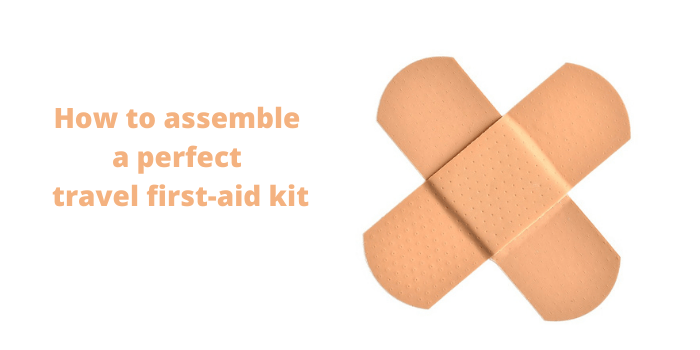
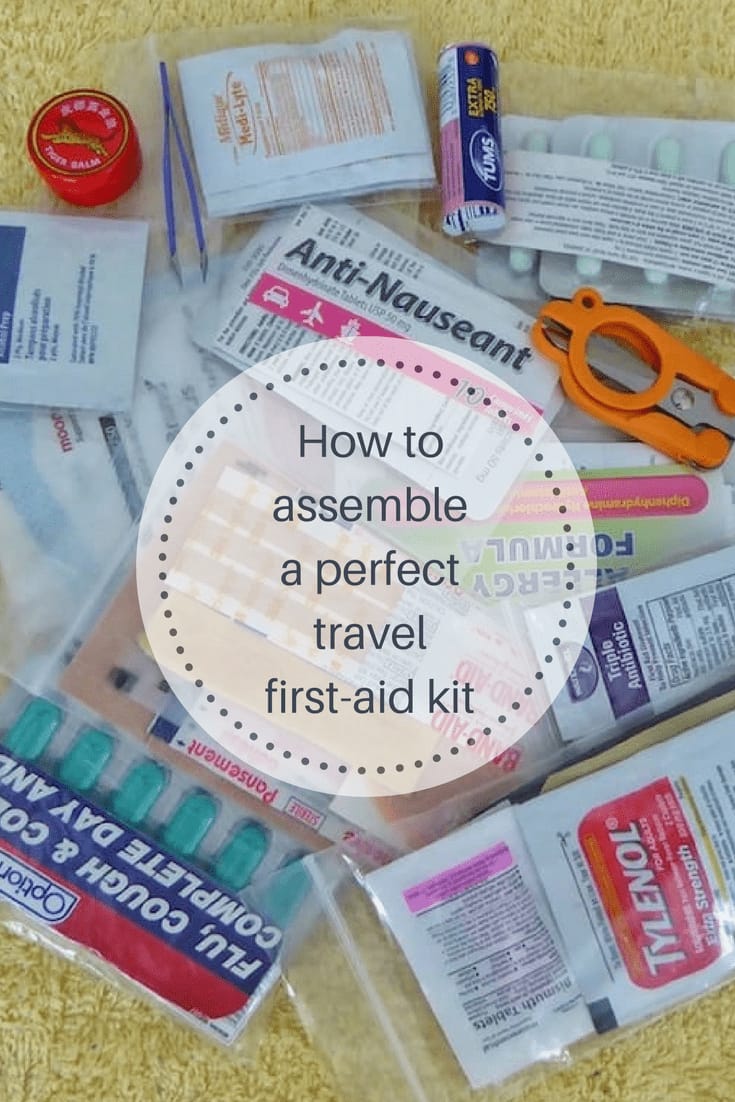




Your thinking is so thorough! I will definitely reread this when the time comes to prepare for my next trip. The one I have with me now is twice the size of yours…
Thank you for this! The steps are so on-point! I’ve been thinking of assembling me and family’s first-aid kit, not because we’re travelling soon but because of the natural calamities happening. We do not know when a storm’s gonna hit or when will there be an earthquake that’s why i’m searching on what to put in a first-aid kit. I’m so thankful I came across this post. This is so helpful! Thank you so much!
Great piece of advice on how to carry your first aid kit while travelling.
Great tips! I love making sure my first aid box is full of everything we might need. I’d suggest every parent take a first aid course so they are prepared.
Very informative read! I agree one must be equipped with a proper first aid kit before venturing out to a new place for vacation or a visit. I usually keep medicines for allergy, gold cough, stomach ache, muscle ache and most importantly for any injury.